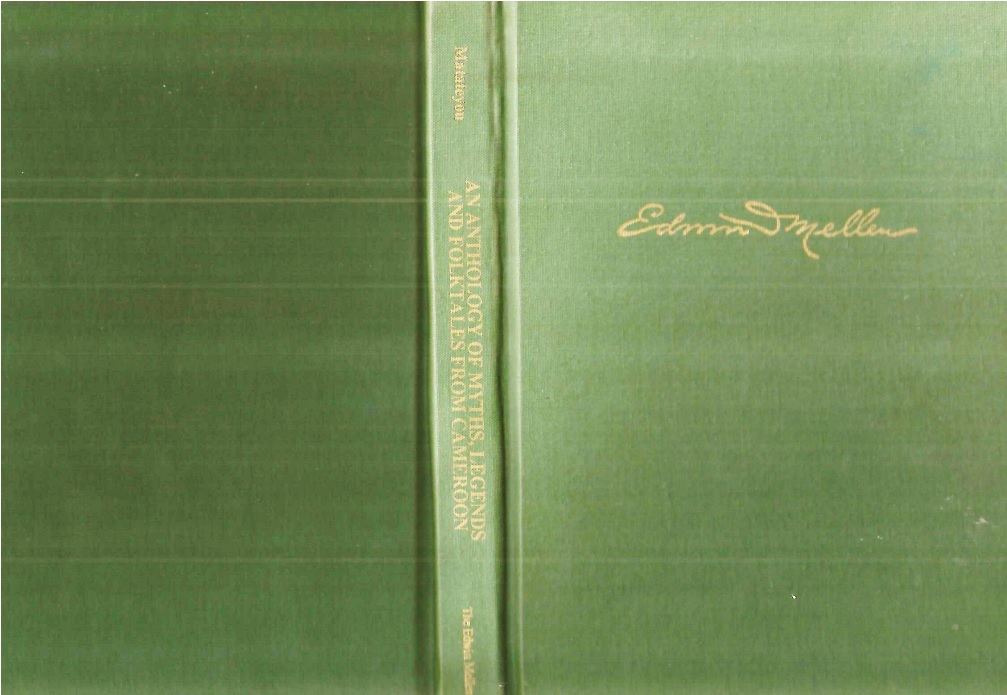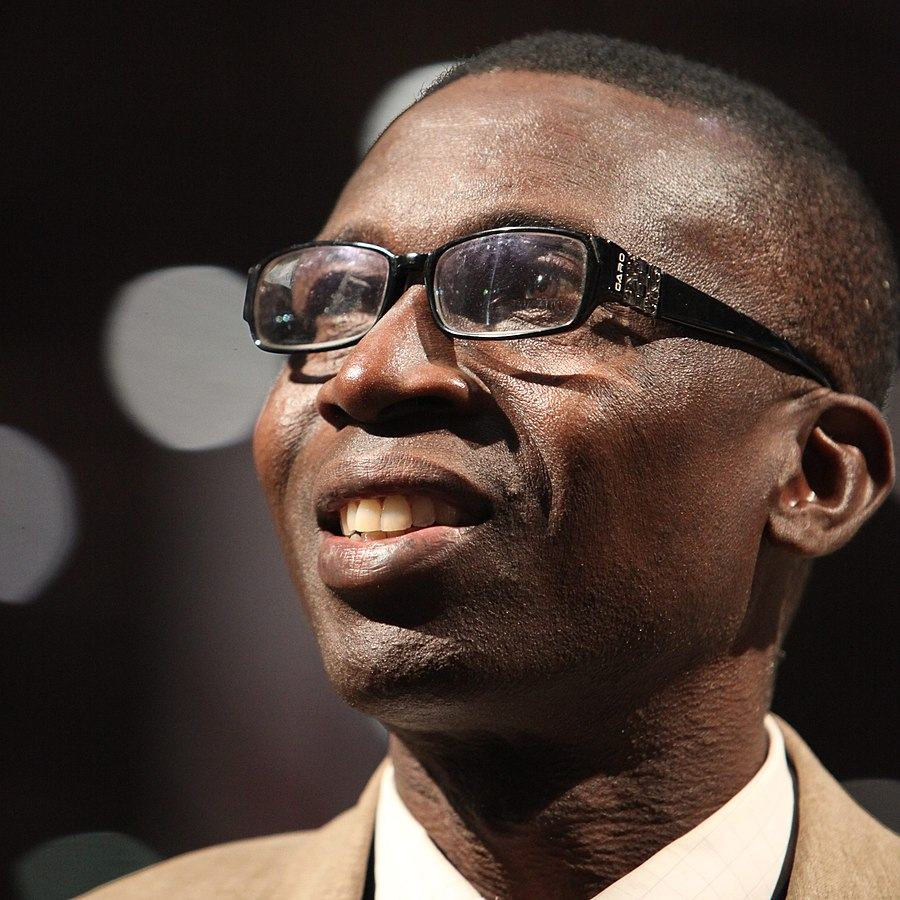Title of the work
Country of the First Edition
Country/countries of popularity
Original Language
First Edition Details
Emmanuel Matateyou, An Anthology of Myths, Legends and Folktales from Cameroon. Lewiston: Edwin Mellen Press, 1997, 255 pp.
Full Date of the Recording of the Story for the Databasey
More Details of the Recording of the Story for the Database
Genre
Myths
Target Audience
Crossover
Cover

The cover of An Anthology of Myths, Legends and Folktales from Cameroon by Emmanuel Matateyou. Courtesy of The Edwin Mellen Press Ltd.
Author of the Entry:
Daniel A. Nkemleke, University of Yaoundé 1, nkemlekedan@yahoo.com
Peer-reviewer of the Entry:
Courage Yaah, University of Yaoundé 1, yaahcourage@yahoo.com
Elizabeth Hale, University of New England, ehale@une.edu.au

Emmanuel Matateyou by Rama. Retrieved from Wikimedia Commons, licensed under Cc-by-sa-2.0-fr (accessed: December 15, 2021).
Emmanuel Matateyou
, b. 1952
(Author, Storyteller)
Emanuel Matateyou is a writer and a professor at the Ecole Normale Supérieure, University of Yaoundé 1. He is a former Fulbright scholar and has published widely on oral literature and Cameroonian culture and languages. Some of his publications include: An Anthology of myths, legends and folktales from Cameroon (1997), Les Merveilleux récits de Tita Ki (2001), Parlons Bamoun (2001), Problématique d’une conciliation du réel et l’irréel (1999), Les sociétés secrètes dans la littérature camerounaise le cas des Bamoun. 2. vol. (1990).
Bio prepared by Daniel A. Nkemleke, University of Yaoundé 1, nkemlekedan@yahoo.com

Andiensa Yuh (Storyteller)
Age of Narrator: 92 (in 1994)
Occupation: Farmer
Language: Kom
Bio prepared by Daniel A. Nkemleke, University of Yaoundé 1, nkemlekedan@yahoo.com
Origin/Cultural Background/Dating
Cultural Background: Kom
Kom is an ethnic group in the North-West region of Cameroon. It is ruled by a powerful Chief, equally called Fon (literally translated as king), together with his advisers who are referred to as the Nchisindos. The people of Kom believe in a supreme deity subordinated by smaller gods, ancestors, spirits, ghosts and totems. With the advent of colonization, a good number of them have adopted Christianity side by side traditional African religion.
Summary
The original published version of this myth appears in: An Anthology of Myths, Legends and Folktales from Cameroon by Emmanuel Matateyou, published in 1997 (pp. 108–116) by The Edwin Mellen Press Ltd. Although we have the written authorization of the publisher and the author to reprint up to 10 myths in the collection for our research on “Our Mythical Childhood…”., we have chosen to summarize this particular myth because the original version is too long. We are therefore very thankful to The Edwin Mellen Press Ltd and Professor Matateyou for granting us this permission.
A certain Fon* passed a law that all male children in his fondom** should be killed for fear that one of them might grow up and usurp his position. For many years women who gave birth to male children were forced to hand them over to the executioners. Then one woman gave birth to a male child, and lied to everyone that it was a girl. She allowed no one to see the baby, claiming that the child was ill. When the boy grew up, she disguised him in female dressing and told him to tell no one about his identity. At the river, he would bathe with his clothes on and remove them only after everyone was safely out of sight. Soon, words reached the king of a strange but very intelligent child who had been nicknamed Mitofchuofoyn — literally: “wiser than the king”, because whenever he played the role of the fon in their mock-heroic acts, he acted wiser than the fon. The fon consulted his magicians and they revealed to him that he was indeed a boy, and not a girl.
From now on, the fon employed several stratagems to kill him. He invited many children to his palace, and to each he gave a nanny-goat. However, to the hero, he gave a billy-goat. He demanded that they raised their goats as their own but must each bring one offspring to him every year. The others did as were instructed except Mitofchuofoyn. When summoned to the palace, he appeared late and excused himself that he was catering for his father who had just given birth. When the elders asked him how this was possible, he in turn asked them how the fon expected his billy-goat to give birth. This forced the fon to shamefacedly dismiss the case. The next day again, the fon invited this child to come over to his house and shave his head. It was a taboo for a commoner to do so. Confronted with the dilemma, Mitofchuofoyn brought some roasted maize and served the fon. He shaved while the fon ate. When he had finished, the fon raised an alarm. When people gathered, the fon asked him to restore his hair or be killed. Mitofchuofoyn told him that if he could restore the grains of maize to their cob, then he would restore his hair. Once again, he had outsmarted the monarch in public, further antagonizing him. This time, however, the fon changed his strategy. He praised Mitofchuofoyn for his superior wits and invited him to join him in the counsel of governance. Then he organised a horse race in the courtyard and assigned a white horse to the hero-child – this was the fastest horse in the palace. Suspicious of this unmerited favour, Mitofchuofoyn swapped his horse with someone who was eager for fame. In the course of the race, guards lurking in nearby bushes shot and killed the rider of the white horse while Mitofchuofoyn rode to victory. Again, the fon praised him and promised to honour him with a crown. He (the fon) asked the guard to dig a deep hole and place the chair on which Mitofchuofoyn was to sit to receive his crown on a platform above the pit. Mitofchuofoyn found out about it and dug a tunnel connecting the hole to their own home. Eventually, during the coronation, the platform gave way and he fell into the hole but moved safely home through the hidden tunnel he had secretly dug. Upon realising this, the enraged king ordered one of his guards to arrest him. He is arrested, tied up and put in a huge basket and made for the river. On his way, the guard saw a bunch of ripe bananas in a nearby farm. He put down his load and went to harvest it. Mitofchuofoyn saw a cock passing by and pleaded with it for help. The cork released him and very quickly he put a stone in the basket and covered it with part of his cloak. After eating the banana, the guard carried the load to the stream, drowned it and proudly returned home. But after several years Mitofchuofoyn reappeared. He was very wealthy and attended by many servants. The king cornered him and asked the source of his wealth and he told him he had gotten it at the bottom of the river. The fon decided that he too will be tied up and thrown into the river so that he could become rich later. Mitofchuofoyn accepted to help him undertake the mission. He tied the fon up, carried him to the stream and dumped him into the depth. The fon drown. Mitofchuofoyn became the new fon in his stead and ended the latter’s evil laws and cruelty to children.
* Chief or King.
** The territory under the jurisdiction of the Chief. It may also be referred to as his kingdom.
Analysis
The myth of Mitofchuofoyn recalls of the story of the Biblical Moses and Pharaoh on whose orders all the male newborns of the Israelites were to be killed in order to avoid the fulfillment of a prophecy, but Moses is hidden and he grows up to fulfill the promise of liberating his people from the tyranny of pharaoh, just like the little boy in the above story. This myth reinforces the belief that where evil reigns, the gods will surely raise someone with special attributes to destroy it. This was Mitofchuofoyn’s mission as his mother succeeds to hide him under the cloak of a girl and he grows up to be very intelligent, able to outsmart the evil ruler each time the ruler lays a trap for him.
Further Reading
Matateyou, Emmanuel, An Anthology of Myths, Legends, and Folktales from Cameroon: Storytelling in Africa, New York: Edwin Mellen Press, 1997.
Addenda
Collected by Njousi David Abang.


